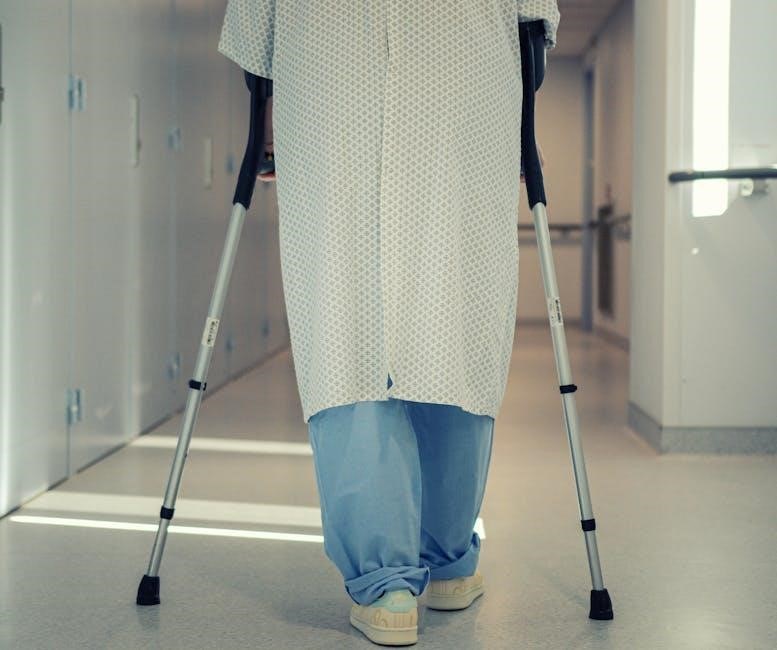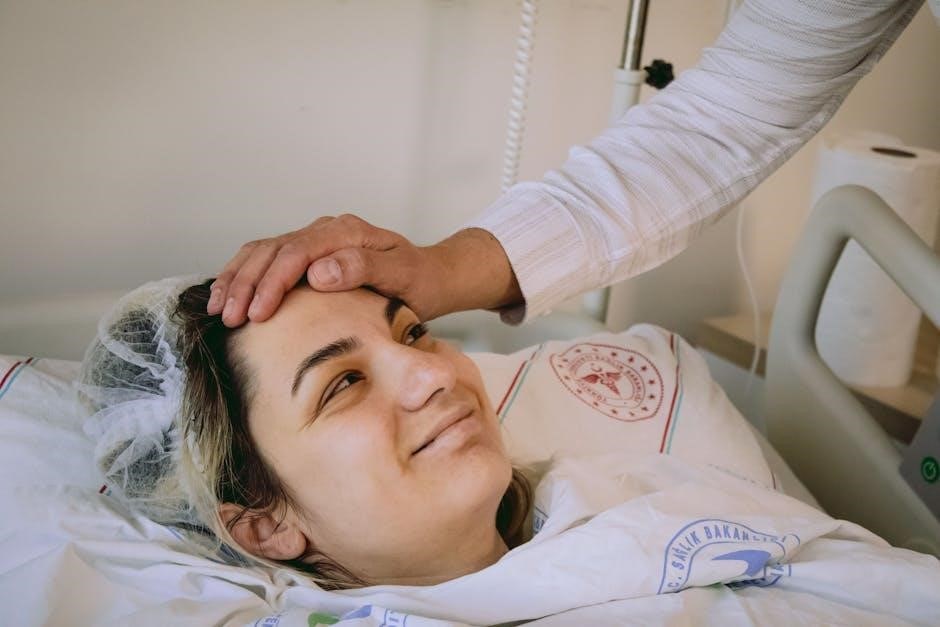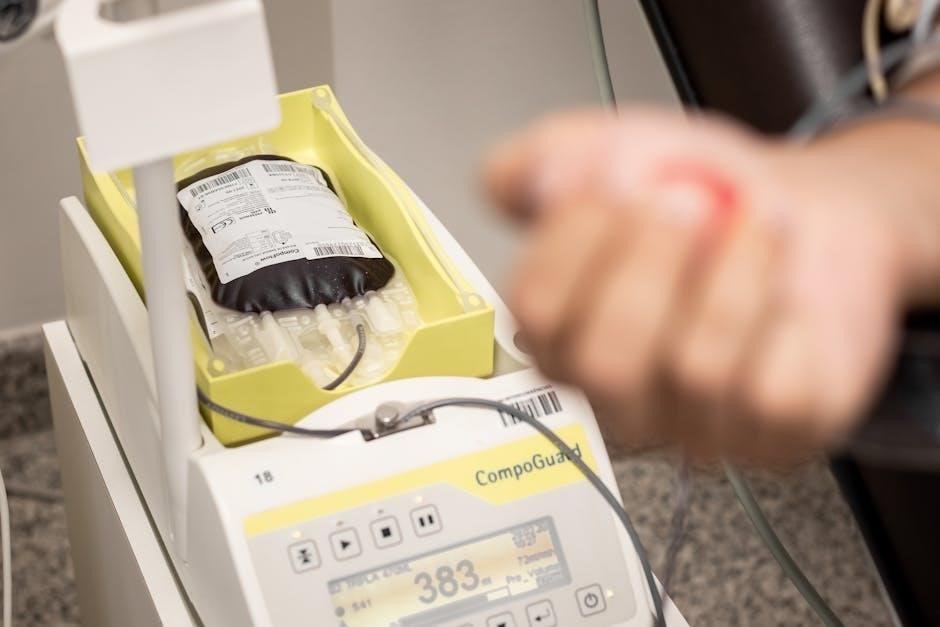The nursing process is a systematic, evidence-based method for delivering individualized, holistic patient care. First introduced by Hall in 1955, it emphasizes assessment, diagnosis, planning, implementation, and evaluation to ensure effective and client-centered outcomes.
Definition and Purpose
The nursing process is a systematic, client-centered method for delivering care. It involves assessing, diagnosing, planning, implementing, and evaluating interventions to meet individual patient needs. The purpose is to provide holistic, evidence-based care that promotes optimal health outcomes. This structured approach ensures consistent, high-quality care by addressing physical, psychological, and social needs. It emphasizes critical thinking and collaboration, making it a cornerstone of professional nursing practice.
Historical Development
The nursing process was first described by Hall in 1955 as a three-step process. By 1967, Yura and Walsh expanded it to four phases, adding assessment. The mid-1970s saw the addition of diagnosis, forming the five-step process widely used today. Initially adopted in the U.S., it was integrated into India’s nursing curriculum after 1980. This evolution reflects the growing emphasis on systematic, patient-centered care, establishing the nursing process as a global standard in nursing education and practice.

Steps of the Nursing Process
The nursing process involves five interrelated steps: assessment, diagnosis, planning, implementation, and evaluation. These steps guide nurses in delivering systematic, client-centered care effectively.
Assessment
Assessment is the first step of the nursing process, involving the systematic collection of subjective and objective data about the patient’s health status. Nurses gather information through interviews, physical examinations, observations, and diagnostic tests. Techniques such as inspection, auscultation, palpation, and percussion are used to identify physical and emotional needs. This step establishes a baseline for care, helping to detect health risks, strengths, and actual or potential problems. Accurate assessment ensures individualized care tailored to the patient’s unique requirements.
Diagnosis
Diagnosis is the second step of the nursing process, where nurses analyze the data collected during assessment to identify actual or potential health problems. This step involves clinical judgment to determine the underlying causes of the patient’s symptoms. Nursing diagnoses focus on the patient’s responses to health conditions, such as pain, anxiety, or activity intolerance, rather than medical diagnoses, which are disease-focused. The diagnosis phase guides the development of targeted interventions to address priority needs and improve patient outcomes. It is a critical thinking process that requires expertise and understanding of human responses to illness.
Planning
Planning is the third step of the nursing process, where goals and outcomes are established based on the patient’s diagnosis. This phase involves developing a care plan tailored to the patient’s unique needs, prioritizing interventions, and setting measurable, achievable, relevant, and time-bound (SMART) goals. The plan is created collaboratively with the patient, family, and healthcare team to ensure adherence and effectiveness. It outlines specific nursing actions, therapies, and educational strategies to address the identified problems. The care plan serves as a guide for implementation and evaluation, ensuring a structured approach to achieving desired patient outcomes. Flexibility is key to adapting the plan as needs evolve.
Implementation
Implementation is the fourth step of the nursing process, where the care plan is put into action. Nurses execute interventions, administer medications, and provide education tailored to the patient’s needs. This phase involves monitoring the patient’s response to treatments and documenting progress. Collaboration with other healthcare team members ensures comprehensive care. The nurse also assesses the effectiveness of interventions and makes necessary adjustments. Clear communication and documentation are critical during implementation to maintain continuity of care and achieve the desired patient outcomes. This step requires flexibility to adapt interventions as needed.
Evaluation
Evaluation is the final step of the nursing process, focusing on assessing the effectiveness of care and patient outcomes. Nurses compare the patient’s current health status with the established goals to determine if they have been met. This step involves documenting the patient’s progress, identifying any remaining needs, and revising the care plan as necessary. Evaluation ensures accountability and continuous improvement in care delivery. It also provides insights for future interventions, promoting high-quality patient outcomes and informed decision-making. Ongoing evaluation supports the dynamic nature of patient care, ensuring it remains patient-centered and evidence-based.

Benefits of the Nursing Process
The nursing process enhances care delivery by ensuring individualized, evidence-based interventions. It improves patient outcomes, promotes accountability, and fosters effective communication among healthcare providers, leading to better patient satisfaction;
Individualized Patient Care

Individualized patient care is a cornerstone of the nursing process, ensuring that each patient receives tailored interventions based on their unique needs and responses. By systematically assessing, diagnosing, and planning care, nurses can address physical, emotional, and social aspects of health. This approach allows for personalized goal setting and interventions, fostering better patient outcomes and higher satisfaction. The nursing process inherently supports flexibility, enabling adjustments to care plans as patient conditions evolve, thereby promoting holistic and effective care delivery.
Systematic Approach to Care Delivery
The nursing process provides a structured framework for care delivery, ensuring consistency and coherence in patient management. By following the five-step sequence—assessment, diagnosis, planning, implementation, and evaluation—nurses can systematically identify, prioritize, and address patient needs. This methodical approach minimizes variability, enhances decision-making, and promotes efficient resource utilization. It also facilitates clear documentation and communication among healthcare team members, ultimately improving the quality and reliability of patient care outcomes.

Challenges in the Nursing Process
The nursing process faces challenges like complexity of patient needs, requiring tailored care, and time constraints that limit thorough implementation of each step, impacting efficiency.
Complexity of Patient Needs
The complexity of patient needs presents a significant challenge in the nursing process. Patients often have diverse, multifaceted conditions requiring tailored interventions. Chronic illnesses, mental health issues, and multimorbidity demand comprehensive care plans. Nurses must address not only physical health but also emotional, social, and cultural factors, adding layers of intricacy. This complexity necessitates a holistic approach, ensuring individualized care that meets unique patient requirements. The dynamic nature of patient needs further complicates the process, requiring continuous reassessment and adaptation of care strategies to achieve optimal outcomes.
Time Constraints and Workload
Time constraints and high workloads significantly impact the nursing process, often limiting the ability to deliver comprehensive care. Nurses frequently manage multiple patients simultaneously, reducing the time available for detailed assessments and individualized planning. Heavy workloads can lead to rushed decision-making, potentially compromising care quality. Additionally, documentation requirements further strain time resources, diverting attention from direct patient care. These challenges underscore the need for efficient time management strategies and supportive staffing models to ensure the nursing process remains effective despite operational pressures. Balancing productivity with patient-centered care is essential for maintaining high standards.

Application of the Nursing Process in Specialized Settings
The nursing process is adaptable across specialized settings like critical care, pediatrics, and geriatrics, ensuring tailored, evidence-based care that meets unique patient needs effectively.
Critical Care Nursing
In critical care settings, the nursing process is vital for managing highly unstable patients requiring close monitoring. Nurses use the process to assess complex physiological conditions, such as cardiovascular or respiratory distress. The systematic approach enables prioritization of interventions, ensuring timely and precise care. Continuous evaluation of hemodynamic data and lab results is crucial. Critical care nurses integrate advanced technologies, like ventilators and hemodynamic monitors, into their practice. The nursing process guides decision-making, ensuring individualized care plans are adapted to the patient’s rapidly changing condition, promoting optimal outcomes in high-acuity environments.
Pediatric Nursing
Pediatric nursing applies the nursing process to address the unique needs of infants, children, and adolescents. Assessment involves evaluating growth, development, and age-specific health concerns. Nurses develop care plans tailored to the child’s stage of development, incorporating play therapy and family-centered care. Implementation includes administering medications and educating parents on care techniques. Continuous evaluation ensures interventions are effective in promoting healthy growth and managing chronic conditions. The nursing process in pediatrics emphasizes a holistic, family-focused approach to support the child’s physical, emotional, and social well-being.
Geriatric Nursing
Geriatric nursing focuses on addressing the unique needs of elderly patients, emphasizing chronic disease management, functional decline, and palliative care. The nursing process involves assessing age-related changes, developing care plans to promote dignity and comfort, and implementing interventions to prevent falls and manage pain. Continuous evaluation ensures tailored strategies meet the patient’s evolving needs. Family involvement and interdisciplinary collaboration are crucial in enhancing the quality of life for older adults, aligning care with their preferences and goals.

Resources for Nursing Process Implementation
Various resources like Nursing Process PDF templates and case studies provide structured frameworks for documenting patient care plans and training healthcare professionals effectively.
Nursing Process PDF Templates
Nursing Process PDF templates are essential tools for healthcare professionals, providing structured frameworks for documenting patient assessments, diagnoses, care plans, and evaluations. These templates ensure consistency and organization in patient records, facilitating clear communication among healthcare teams. They often include sections for goal setting, intervention plans, and outcome tracking, making it easier to monitor patient progress. Many templates are customizable to suit specific clinical settings or patient populations, offering flexibility and adaptability. They also serve as valuable educational resources for nursing students and practitioners, promoting standardized and evidence-based care delivery. Additionally, these templates can be easily shared and accessed digitally, enhancing workflow efficiency and patient care outcomes.

Case Studies and Examples

Case studies and examples provide practical insights into applying the nursing process in real-world scenarios. They often include detailed patient histories, assessments, diagnoses, and care plans, demonstrating how each step of the nursing process is executed. For instance, a case study on a post-surgical patient might illustrate how a nurse assesses pain, develops a plan for pain management, and evaluates the effectiveness of interventions. These examples are invaluable for educating nursing students and professionals, helping them understand the process through tangible, evidence-based applications.

Future Trends in the Nursing Process
Future trends include integrating advanced technologies like AI and telehealth into care delivery, enhancing data-driven decision-making, and focusing on preventive care to improve patient outcomes and reduce costs.
Integration of Technology
The integration of technology into the nursing process enhances care delivery through tools like electronic health records (EHRs), telehealth, and AI-driven diagnostic systems. These innovations streamline data collection, improve accuracy in diagnoses, and enable personalized care plans. Real-time patient monitoring and predictive analytics support proactive interventions, reducing hospital readmissions and improving outcomes. Technology also facilitates seamless communication between healthcare teams, ensuring coordinated care. By leveraging these advancements, nurses can deliver more efficient, evidence-based, and patient-centered care, aligning with the evolving demands of modern healthcare.
Focus on Preventive Care
The nursing process increasingly emphasizes preventive care to address health issues before they escalate. By identifying risk factors during assessment, nurses can implement targeted interventions to promote health and prevent complications. Education on lifestyle modifications, disease management, and early detection of symptoms is crucial. Preventive measures, such as health screenings and vaccinations, are integrated into care plans to reduce hospitalizations and improve long-term outcomes. This proactive approach aligns with the nursing process’s goal of holistic, patient-centered care, fostering healthier communities and reducing healthcare costs.
